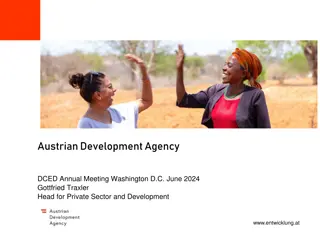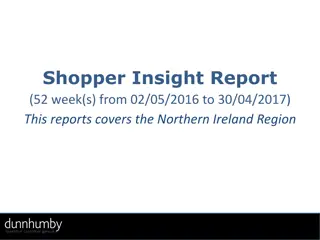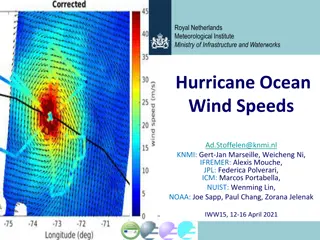Challenges in Transitioning Austrian Energy System to High Wind Energy Penetration
The transition of Austria's energy system to embrace high wind energy penetration requires consideration of various factors such as economic incentives, costs, social norms, individual values, and beliefs. Through the TransWind project, research questions are examined, including the techno-economical potential for wind energy, patterns of acceptance, and the embedding of interests in narratives related to renewable energy. The study employs participatory integrated assessment methods to explore these aspects and model the techno-economical potential for wind energy in Austria.
Download Presentation

Please find below an Image/Link to download the presentation.
The content on the website is provided AS IS for your information and personal use only. It may not be sold, licensed, or shared on other websites without obtaining consent from the author.If you encounter any issues during the download, it is possible that the publisher has removed the file from their server.
You are allowed to download the files provided on this website for personal or commercial use, subject to the condition that they are used lawfully. All files are the property of their respective owners.
The content on the website is provided AS IS for your information and personal use only. It may not be sold, licensed, or shared on other websites without obtaining consent from the author.
E N D
Presentation Transcript
THE TRANSITION OF THE AUSTRIAN ENERGY SYSTEM TO A HIGH PENETRATION OF WIND ENERGY: VISIONS, VALUES AND COSTS 4. September 2017 IAEE, TU Vienna Patrick Scherhaufer Stefan H ltinger Boris Salak Thomas Schauppenlehner Johannes Schmidt University of Natural Resources and Life Siences, Vienna Department of Economics and Social Sciences Institute of Forest, Environmental, and Natural Resource Policy Institute for Sustainable Economic Development Department of Landscape, Spatial and Infrastructure Sciences Institute of Landscape Development, Recreation and Conservation Planning www.transwind.boku.ac.at
What is the problem? The acceptance or non-acceptance of a particular renewable energy technology is depended on complex set of economical incentives, costs, social norms, individual values, preferences, and beliefs at various levels of decision-making. W stenhagen et al. 2007 TransWind Presentation| 04.09.2017 | IAEE TU Vienna
Research Questions of TransWind What is the techno-economical potential for wind energy in Austria? Market & Socio-political Acceptance What are the decisive patterns of acceptance and non-acceptance? Community & Socio-political Acceptance How are interests, rationales and beliefs embedded in different narratives (stories) about renewable energy? TransWind Presentation| 04.09.2017 | IAEE TU Vienna
Materials & Methods: A participatory integrated assessment 1 WorldCaf 28 semi structured interviews 1 questionnaire 3 participatory workshops with experts from the stakeholder group 6 case studies 4 visualisation courses 8 focus group discussions 8 semi structured interviews with local stakeholders Participatory modelling: Techno-economical wind energy potential Triangle based on W stenhagen et al. 2007 TransWind Presentation| 04.09.2017 | IAEE TU Vienna
The techno-economical potential: Overview of the modelling steps TransWind Presentation| 04.09.2017 | IAEE TU Vienna
The techno-economical potential: Criteria catalogue for the 3 participatory scenarios scenarios of potential wind turbine sites med GIS data-set min max topological restrictions Areas above alpine forest line maximum slope (degrees) water bodies offset distance to settlements and infrastructure settlement areas (m) a buildings outside of settlement areas (m) b building land outside of settlement areas (m) built-up areas c railways motorways, primary and secondary roads airport public safety zones d power grid (>110kV) suitability of protected areas and offset distances national parks (m) excluded 5.7 excluded excluded 8.5 excluded excluded 11.3 excluded Kilian et al. (1994) SRTM DEM 90m Corine LC 5 2000 1000 1000 300 300 300 5100 250 1200 750 750 300 300 300 5100 250 1000 750 750 300 300 300 5100 250 IACS OSM buildings federal land use plans federal land use plans OSM OSM AustroControl OSM no (3000) no (2000) no (1000) CDDA potentiallyf Natura 2000 -habitats directive sites (m) no (2000) no Natura 2000 Natura 2000 - birds directive sites (m) no (2000) no no Natura 2000 other protected areas (m) e important birdlife areas major migration routes for wild animals forest areas lakes >50ha (m) no (2000) no no no (1000) 3000 no no CDDA IBAs potentiallyf potentiallyf yesg 1750 potentiallyf potentiallyf yes 1000 ACC, K hler (2005) Corine, AFDP Corine LC 512 TransWind Presentation| 04.09.2017 | IAEE TU Vienna
Spatial distribution of potential areas for wind turbines in the four scenarios TransWind Presentation| 04.09.2017 | IAEE TU Vienna
Supply curves showing the economic wind energy potential for the four scenarios 10% share of total electricity demand -> 6,20 8,05 TWh 20% share of total electricity demand -> 12,40 16,10 TWh TransWind Presentation| 04.09.2017 | IAEE TU Vienna
Sensitivity analysis TransWind Presentation| 04.09.2017 | IAEE TU Vienna
Spatial distribution of optimal wind sites Comparison of medium scenario (blue) with federal suitability zones (yellow) Wind energy production of 12,4 TWh (= 20% share of wind energy at a total electricity demand of 62 TWh) TransWind Presentation| 04.09.2017 | IAEE TU Vienna
The techno-economical potential: Policy Conclusions The already existing suitability zones exclude many optimal sites, which are possible in our medium scenario. It is important to harmonize the legal framework conditions for defining suitable areas for wind energy in Austria. Applying them for all federal states could avoid economic inefficiencies and reduce wind energy expansion costs. The challenge for policy makers will be to find the right balance between limiting wind production to sites with minimal negative effects on landscape scenery, human health and the environment; and providing enough potential wind turbine sites to allow the deployment of wind energy at feasible costs. TransWind Presentation| 04.09.2017 | IAEE TU Vienna
Many thanks for listening! Patrick Scherhaufer patrick.scherhaufer@boku.ac.at Stefan H ltinger Boris Salak Thomas Schauppenlehner Johannes Schmidt www.transwind.boku.ac.at University of Natural Resources and Life Siences, Vienna Department of Economics and Social Sciences Institute of Forest, Environmental, and Natural Resource Policy Institute for Sustainable Economic Development Department of Landscape, Spatial and Infrastructure Sciences Institute of Landscape Development, Recreation and Conservation Planning
Overview of participating organisations in TransWind group public authorities organizations Austrian Ministry for Transport, Innovation and Technology; Federal Ministry of Science, Research and Economy; Austrian Energy Market Regulator E-control; Chamber of Labour; Chamber of Commerce Federal State Government Offices of Burgenland, Lower Austria, Salzburg and Styria; Ombuds Offices for Environmental Protection (Umweltanwaltschaft) of Burgenland, Lower Austria and Styria federal state authorities wind park developers and operators Energie Burgenland Windkraft GmbH; EVN Naturkraft GmbH; kostrom AG; P SP K Group; WEB Windenergie AG; Windkraft Simonsfeld AG Austrian Environmental Umbrella Association (Umweltdachverband); BirdLife Austria; Coordination Centre for the Study and Protection of Bats Austrian Power Grid (APG); Austrian Wind Energy Association (IG- Windkraft); the processing and administration centre of the subsidies for eco-electricity (OeMAG) environmental and nature conservation groups others TransWind Presentation| 04.09.2017 | IAEE TU Vienna
Mean and range of parameter values for assessing the economic potential cost element unit mean value range references EUR kW-1 capital expenditures 1675 1600-1900 1, 2, 3, 7 EUR MWh-1 operational expenditures 26.4 18.5-34.2 3, 2, 4, 5 lifetime years 20 - 5, 6, 7 discount rate % 5 - 4, 5, 7 References: (1) Ar ntegui, 2014 (2) Gass et al., 2013 (3) Hantsch et al., 2009 (4) Rehfeldt et al., 2013 (5) Kost et al., 2013 (6) McKennaet al., 2014; (7) Falkenberget al., 2014 TransWind Presentation| 04.09.2017 | IAEE TU Vienna
Potential capacity and annual wind energy generation in Austrian federal states Min scenario med scenario max scenario Suitability zones GW TWh GW TWh GW TWh GW TWh Burgenland 0.7 1.9 4.9 10.9 6.1 13.5 1.4 3.6 Carinthia 3.2 4.9 5.5 8.3 Lower Austria 1.0 2.0 19.5 38.9 22.0 43.8 3.6 8.4 Upper Austria 0.0 0.0 4.4 6.8 6.4 9.8 0.9 1.4 Salzburg 1.2 1.6 2.2 2.7 Styria 5.0 7.8 8.4 13.1 0.5 0.9 Tyrol 0.0 0.0 0.4 0.5 0.9 1.0 Vorarlberg 0.0 0.0 0.2 0.3 0.4 0.4 Austria 1.7 3.9 38.8 71.6 51.8 92.8 6.3 14.3 TransWind Presentation| 04.09.2017 | IAEE TU Vienna























